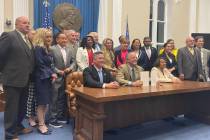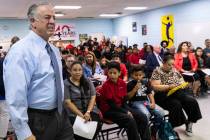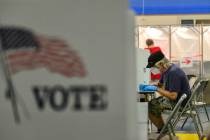Honoring a great community asset: the library
When I was young, a couple of times each month, I’d take a trip with my mom and sister to the Main Street branch of the Huntington Beach public library.
Not only did I get my very own library card, but I got to choose my own books. After mastering the card catalog — which in those days was comprised of actual cards — I walked out with armloads of books.
The Main Street branch is still there today, although it’s somewhat different. There are computers to look up books now, and a back room has been transformed into a computer lab. The librarians don’t physically stamp a card with the due date of your book, either.
But that beautiful old building where the seeds of my adult career as a writer were planted is still there, still welcoming new generations of moms and kids, still sparking imaginations and building minds.
I thought of my childhood library when I noticed that this week is National Libraries Week.
And we’ve got a lot to celebrate in Southern Nevada.
For example, did you know that more than 500,000 people visit a branch of the Las Vegas-Clark County Library District every month? That between 17 million and 18 million items are checked out every year? That programs for everybody from preschoolers through senior citizens happen every day in urban library branches?
“We’re busier than ever, especially with the recession,” says Jeanne Goodrich, executive director of the library district. “It’s a free activity that’s for the whole family. There’s something for everyone.”
In fact, you don’t even have to come into a branch for some services, including downloading borrowed e-books to your Kindle or iPad. Even if you don’t have a computer at home, they’re available — and very popular — at your local library branch. (Goodrich recommends calling ahead to reserve time.)
Interestingly, the busiest libraries are in Las Vegas’ poorest areas, where the library has become not just a place to check out books, read newspapers or magazines, do research for school or check out a DVD, but a community gathering place as well. And libraries extend the school year with summer reading programs aimed at keeping kids sharp on their skills while out of school for three months.
“It keeps that summer slide from occurring,” says Tom Fay, director of the Henderson Library District. The Henderson district’s six libraries serve about 100,000 people each month, and circulate about 1.8 million items each year, he said.
The best thing about the summer reading program is that it allows kids to read what they want, without being told what’s appropriate for their grade level. “We’re not here to limit, we’re here to expand,” he said.
And while circulation numbers of printed books have increased, circulation of electronic materials — including e-books, books on tape and other similar items — has jumped as much as 150 percent. “I think you’ll really see libraries as the mediator between the two [print and electronic] formats,” he said. “All reading is important.”
Libraries have always been innovators. The card catalog was an Internet browser long before the Advanced Research Projects Agency developed the Internet. The Dewey decimal system was the original version of Amazon’s “frequently bought together” feature. And libraries did it all without Wi-Fi, and made it available to the masses. “This is every man’s university,” Fay said.
With so much attention focused on government waste (hello, GSA scandal), it’s high time we celebrated one of the coolest things our tax dollars pay for, the public library. National Libraries Week is the perfect time to do it.
Steve Sebelius is a Review-Journal political columnist and author of the blog SlashPolitics.com. Follow him on Twitter (@SteveSebelius) or reach him at (702) 387-5276 or ssebelius@reviewjournal.com.












